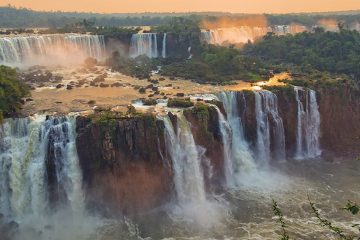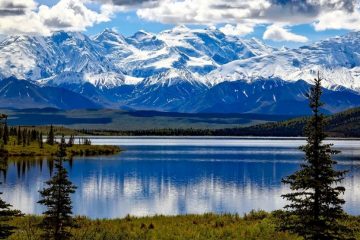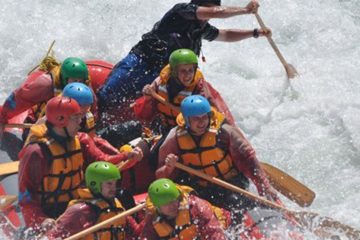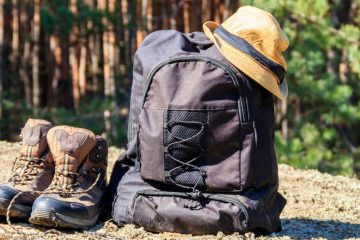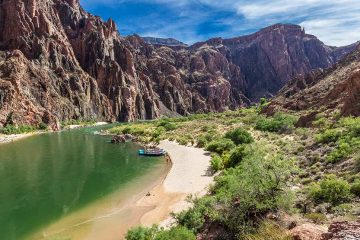Explore the Stunning Scenery of Zion National Park on These Top Hikes
Utah’s Zion National Park is a great destination for hiking. With beautiful surroundings and a true wilderness feel (even if you happen to be surrounded by tourists), it’s not hard to have an incredible time hiking, regardless of whether you’re on a leisurely stroll or taking advantage of the park’s more difficult offerings.
Zion has trails for every kind of visitor, from families with small children to thrill-seeking adventurers. You’ll find easy hikes on our list including paved trails that are wheelchair and stroller accessible, longer hikes that are a lot more strenuous, and even a couple of overnight trips. We’ve also made sure to include the trails in Zion that often make hiker’s bucket lists, such as the Zion Narrows and the Subway.
Zion Canyon is the most visited part of the park. This area offers easy, moderate and strenuous hikes, so many of our listed trails are located in this section of the park. Some of the more strenuous hikes are in the outlying areas, however. Many hikes are only accessible by the park shuttle from spring to fall, so we’ve listed the appropriate shuttle stop for each hike. Due to park conditions, trail closures often occur, so check the park website before your trip to make sure you aren’t disappointed.
While hiking the trails of Zion National Park is an unforgettable experience, the environment in the park can be quite harsh at times. Each year many people are rescued from the park, so make sure to take careful precautions and heed all warnings before heading out on your hike.
With all that in mind, here are the Zion National Park hikes we recommend.
Easy Hikes
There are a number of easy hikes in Zion National Park. Many are great for kids and some are even wheelchair accessible with a bit of assistance. All of the following hikes are a great way to experience the nature and culture of Zion National Park in less than three-and-half miles and without gaining more than 100 feet in elevation. They are also great hikes for those who want to do a bit of hiking in Zion but don’t have much time.
Pa’rus Trail
Pa’rus Trail is three-and-a-half-mile paved trail that winds from South Campground alongside the Virgin River to Canyon Junction. The trail is accessible by wheelchair with some assistance and by stroller. The trail has the distinction of being the only trail in the park that allows leashed pets and bicycles.
Before you start on your hike, be sure to take a stop at the Zion Canyon Visitor Center to use the restroom and fill your water bottle. You can find the trailhead from the Visitor Center shuttle stop (Shuttle Stop #1). It’s just up the canyon from the Zion Canyon Visitor Center and across the bridge next to South Campground. You can also access this trail from the Canyon Junction stop (Shuttle Stop #3) or a short connector trail from the Museum stop (Shuttle Stop #2). Be aware, however, that this short connector trail is not accessible by wheelchair, bikes or pets.

Virgin River Nature Trail
The Virgin River Nature Trail is another trail that’s easily accessible from the Visitor Center (Shuttle Stop #1). The trailhead is right near the restrooms and the trail is a short paved path that is both stroller and wheelchair accessible. It is perfect for elderly visitors, small children, or anyone who can’t walk very far but wants to experience the park.
The highlight of the trail is the easy access to the Virgin River where you’ll see people stopping to relax and stick their feet in the refreshing water.
You'll need a sense of adventure if you're planning on seeing the best places to travel in South America for yourself. But you'll love every minute of it.
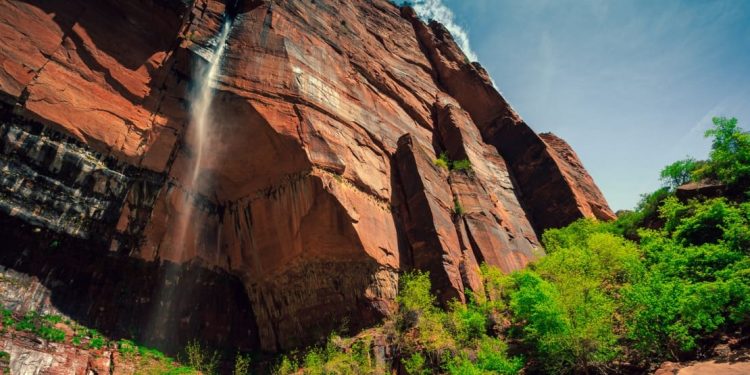
Lower Emerald Pool Trail
This 1.2-mile trail is accessed by the path across the road from Zion Lodge (Shuttle Stop #5). The trail is fairly easy and flat, which makes it good for families with kids. It is mostly paved, although there are some minor drop-offs and you may need help in spots if you are traveling with a stroller.
The trail leads to the Lower Emerald Pool and some waterfalls, and also provides access to the Upper Emerald Pool and Kayenta Trails. Swimming is never permitted in the Emerald Pools. You can find stations to fill your water bottles as well as restrooms near the trailhead at the Zion Lodge.

Moderate Trails
The trails on our moderate trails list all have larger elevation gains than the above trails and cover distances ranging from one to 7.6 miles. The trails generally offer amazing views of the Zion Canyon and the park’s stunning natural beauty.
They are not recommended for those with very young children, the elderly or those with physical limitations. They could be great options for families traveling with older kids though! If you’re looking to add a little adventure to your trip without the need for formal wilderness skills or training, these trails provide a great option.
Proper planning does become more important on these hikes, however, as does knowing your physical limitations. Be sure to wear proper footwear and bring a good supply of water and snacks.
Watchman Trail
Easily accessible from the Visitor Center (Shuttle Stop #1), Watchman Trail begins across the road and up the canyon (just follow the river to the trailhead). The trail is relatively short — about three miles round trip — and offers nice views of the famous mountain, The Watchman (although it does not reach the top), and the Visitor Center Complex above.
The trail isn’t the most exciting one in the park and it doesn’t have the most amazing views, but it is pleasant, especially in the fall or spring. It also offers the benefit of often being less crowded than the more popular trails. Most older kids could do this trail. However, pay close attention as there are several drop-offs along cliff edges where you need to be careful.
Do note that the entire trail is in the sun, so you’ll want to make sure to bring sunscreen and would be better off doing the hike early in the morning when this section of the canyon is shaded, or on a cloudy day.
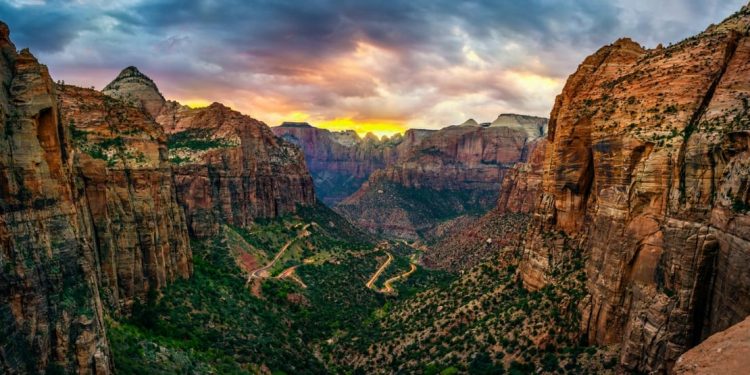
Canyon Overlook Trail
The Canyon Overlook Trail is a Zion National Park classic. If you are visiting the park for the first time, you should certainly consider this trail. The hike is about one-mile and takes less than an hour to complete.
Driving to the trailhead is half the fun if you have your own car. You’ll follow Route 9 east which takes you through the landmark Zion-Mt. Carmel Tunnel and offers stunning views of the Upper East Canyon. If you’re driving from the east entrance of the park, the trailhead is located just before the Zion-Mt. Carmel Tunnel.
The hike is short and relatively easy. You’ll pass through a large cave and can then enjoy one of the best photography spots in the park: a stunning view of the main section of Zion Canyon. This hike isn’t strenuous at all, but we’ve included it in the moderate section because of several exposed spots along the trail which pose a risk of falling. As always, before hiking in Zion (or any park), make sure someone knows your plans for the day and check back in after you complete your hike.
If you are a traveler who is excited by wilderness, then Alaska is a destination for you. With beautiful nature, here is what to do in Alaska.
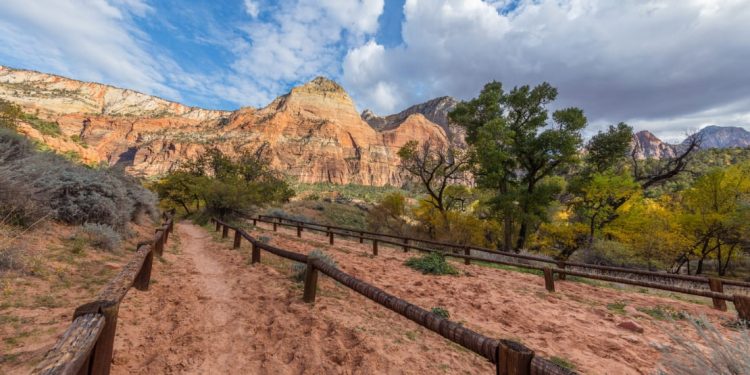
Sandbench Trail
This hike isn’t the most enjoyable hike in the park, as the path is very sandy and much of the trail is exposed to the hot sun during the day. It is also the main trail for guided horseback riding trips through the park from March to October which can add to the unpleasantness. However, it offers scenic views of an ancient rockslide and the Court of the Patriarchs.
You can also access the Emerald Pools via a short spur trail. There are eastern and western loop sections of the trail, with both offering unique views. The eastern section is rocky and features interesting boulders and rock features as well as nice views of the main section of the canyon. Alternatively, the western loop offers views of the ancient landslide.
Due to the often intense summer heat on this trail, summer hiking isn’t recommended, but spring and fall can be pleasant. Horseback riding is one of the best ways to experience this trail if you are looking for a break from all of the hiking you’ve been doing as you worked your way through this list! To get here, take the shuttle to Zion Lodge (Shuttle Stop #5). The hike is 7.6 miles round trip and takes approximately five hours.
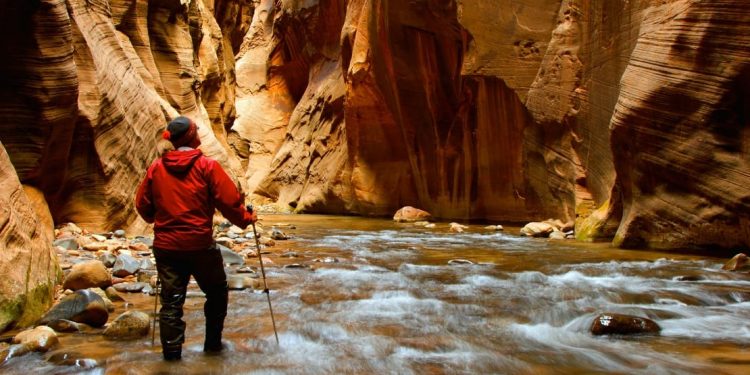
Strenuous Hiking Trails
The hikes we’ve included in this section are physically as well as mentally challenging. They may include dangerous sections that involve walking along cliff edges with chains to support you, and some require canyoneering skills. The following trails all range from two-and-a-half to 16 miles and climb up to 2,148 feet in elevation.
These sorts of hiking trips involve significant advance planning and preparation. Be sure to pack sufficient water and check current weather conditions before heading out. Even though summer is a very popular time to hike at Zion National Park, the risk also increases during this time of year due to extreme temperatures and frequent rain and thunderstorms which can all make these trips more dangerous.
Be sure to let someone know your hiking plans in advance before heading out to, especially on any of these more strenuous trips. And be sure to bring the proper gear with you. Having a compass and knowing how to use it can be essential, even if a place claims the trails are well-marked.
Zion Narrows via Riverside Walk
The Narrows is a gorge with thousand-foot-tall walls and a river which passes through the narrowest section of Zion Canyon. There are two main ways to experience the Zion Narrows. The first and easier route is most popularly known as the “bottom-up” Narrows and is hikeable without a special hiking permit. You cannot hike further than Big Spring, nor is hiking in Orderville Canyon permitted.
While not very steep compared to other hikes in this section, this trail is rough and can be very slippery as it involves hiking in the Virgin River. More than half of the hike is spent in the water either wading, walking or sometimes even swimming. The water can be quite cold and fast-moving, and the path is slippery. It’s imperative that you check the weather and follow any warnings about flash flooding as floods can quickly turn deadly in The Narrows.
The trailhead is accessed by taking the shuttle to the Temple of Sinawava Trail (Shuttle Stop #9). From there, follow the Riverside Walk for one mile. This is a mostly-flat paved trail that winds along the Virgin River. There may be a fair amount of foot traffic along this section, as this is a family-friendly trail. Don’t worry though, you’ll soon leave the crowds behind.
When you reach the end of the Riverside Walk, you’ll begin wading in the river. It’s an out-and-back trail, so you return the same way you came. Many visitors try to reach Orderville Canyon which makes the trip about 10 miles round trip. There are no restrooms in The Narrows so make sure to use them at the Temple of Sinawava before you head out.
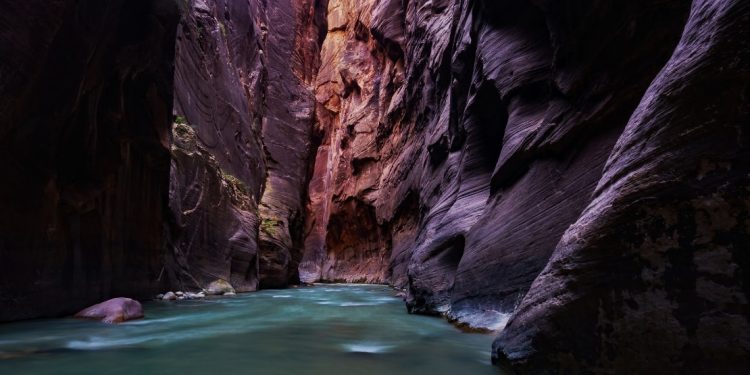
The Narrows “Top-Down”
One of the most unforgettable ways to experience Zion National Park is to hike The Narrows from the top down. The 16-mile stretch of narrow gorge in the upper section of Zion Canyon is enclosed by walls up to 2,000 feet tall.
The hike doesn’t follow a specific trail, rather the route is the Virgin River. 80% or more of the hike requires walking, wading or swimming in the river. The current can be very fast, and the water is always cold. Slipping on the rocks is a constant issue and you must be incredibly careful to avoid flash flooding and hypothermia. Even though this is sure to be a memorable experience, proper planning and equipment are essential to avoid a difficult or even tragic end to your trip.
This hike requires a permit which are only issued when the river speed is below 120 cubic feet per second. In the best conditions, hikers can make the 16-mile trip in about 12 hours. For those who wish to make the trip at a more relaxed pace, spending one night in the gorge is a good idea.
Overnight camping is allowed at permitted sites and you are only allowed to stay for one night. The campsite capacity is limited to 12 numbered sites and these can often fill up to capacity on the weekends, so reservations are recommended.
You’ll need two cars or a shuttle for this trip, as the trailhead at Chamberlain’s Ranch is a one-and-a-half-hour drive from the end of the trail at the Temple of Sinawava.
Do you and your significant other love getting outside your comfort zone? These adventure vacations for couples are sure to strengthen your bond!
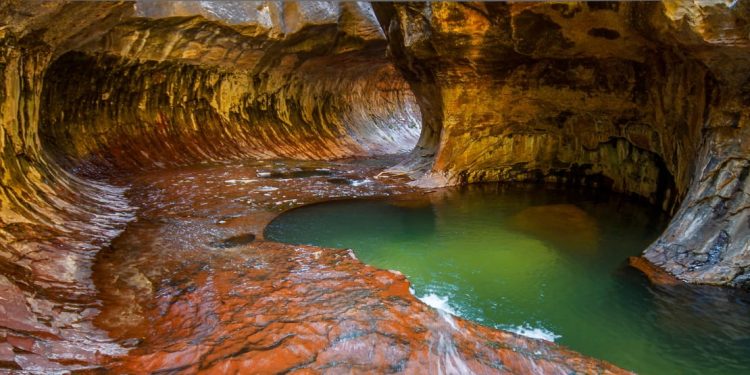
The Subway
The Subway is one of the most beautiful hikes in Zion National Park. Like The Narrows, the hike can be done in either “top-down” or “bottom-up” fashion. The classic way to do the hike is to travel the top-down route which follows the Left Fork of North Creek. The trip takes six to 10 hours of difficult hiking with some technical canyoneering skills required.
The trip covers about 10 miles and involves some rappelling, several climbs and a few swims through cold water. The views along the trail are absolutely amazing and very photogenic as you experience some of the most beautiful slot canyons that Zion National Park has to offer.
The hike is extremely technical in sections and not only should hikers have the skills required to navigate the trail, but proper canyoneering gear is a must. A climbing harness, ropes and rappel device are required. Due to the cold water, wet suits are highly recommended during cool weather. There is a high risk of flash flooding in the canyon and the hike should not even be considered if rain is likely. The hike begins at the Wildcat Canyon Trailhead and ends at the Left Fork Trailhead, so you will need two cars or will need to arrange a shuttle in advance.
If you don’t have the technical skills required for canyoneering, you should instead consider the Subway “bottom-up” route which is a strenuous hike that has many obstacles but does not require technical canyoneering skills. It’s a great way to experience the beauty of this unique slot canyon without the rappelling and swimming required of the top-down route.
The hike begins and ends at the Left Fork Trailhead and travels about 3.3 miles each way, taking from five to nine hours to complete the entire route. The hike is quite strenuous as it travels through rugged terrain which includes steep and loose sections and traversing a river with many obstacles. Many sections are wet and can be slippery. While you won’t need any canyoneering gear to finish the hike, it should not be underestimated and proper planning and gear are required.
Both the top-down and bottom-up hikes require a permit. Due to its immense popularity, the National Park Service has created a lottery system that grants permits to 80 people per day. Please check the NPS website for more information about obtaining a permit.



